The Precision-Fermented Functional Lipids Market is expected to reach a valuation of USD 635.6 million in 2025 and is projected to attain USD 1,116.2 million by 2035. This rise of USD 480.6 million reflects a 76% increase over the decade, corresponding to a CAGR of 5.8%.
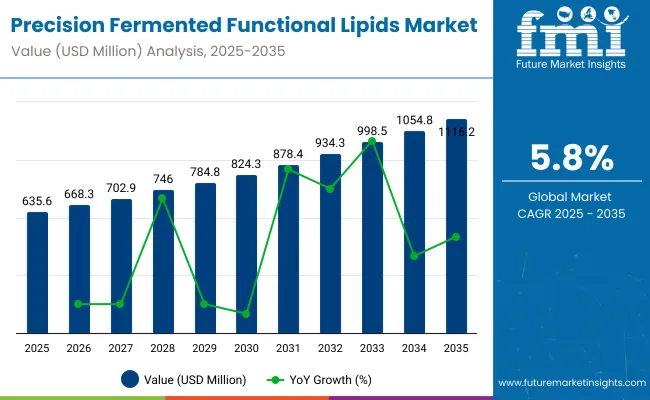
Precision Fermented Functional Lipids Key Takeaways
| Metric | Value |
|---|---|
| Estimated Value in (2025E) | USD 635.6 million |
| Forecast Value in (2035F) | USD 1,116.2 million |
| Forecast CAGR (2025 to 2035) | 5.8% |
A two-phase growth pattern has been observed across the forecast period, driven by continuous innovation, strain optimization, and regulatory advancements in microbial fermentation technologies.During the first half of the decade, from 2025 to 2030, the market is anticipated to expand from USD 635.6 million to approximately USD 842.5 million, contributing USD 206.9 million, which represents nearly 43% of the total decade growth.
This phase is expected to be characterized by the early commercialization of precision-fermented omega-3, ceramides, and structured lipids in infant formula, functional foods, and cosmeceuticals. Regulatory clarity in North America and Europe is likely to enhance ingredient approval rates, fostering gradual mainstream adoption.
In the second half, spanning 2030 to 2035, accelerated growth is forecasted as the market scales from USD 842.5 million to USD 1,116.2 million, adding USD 273.7 million, equal to 57% of total growth. This momentum is projected to be supported by full-scale bio-manufacturing integration, sustainability mandates in food and personal care, and heightened investor confidence. Market leadership is expected to shift toward firms offering end-to-end lipid fermentation platforms, supported by strategic collaborations and IP-backed portfolios.
From 2020 to 2024, the Precision-Fermented Functional Lipids Market expanded from USD 420 million to USD 635.6 million, driven by increased adoption of omega-3 alternatives and structured lipids in infant nutrition and clinical-grade supplements. Market leadership was held by companies like Corbion, DSM-Firmenich, and Ginkgo Bioworks, with dominant control over strain libraries, fermentation infrastructure, and downstream integration. Competitive differentiation was defined by bioprocess scalability, product purity, and regulatory approval pathways, while platform licensing and ingredient formulation partnerships gained traction.
By 2025, the market is projected to reach USD 635.6 million, with increasing focus on platform-as-a-service (PaaS) business models. The revenue mix is expected to shift significantly, as microbial strain licensing, biofoundry services, and AI-led pathway optimization collectively exceed 30% of total value by 2030. Traditional fermentation leaders are pivoting toward end-to-end lipid delivery ecosystems, while newer players are gaining share through personalized lipid solutions, cloud-based formulation platforms, and nutrigenomics-driven demand.
Growth in the precision-fermented functional lipids market is being fueled by increasing demand for sustainable and bioidentical lipid alternatives in food, nutrition, and personal care sectors. Conventional sources of functional lipids have been associated with supply volatility, ethical concerns, and environmental burden, which has prompted a shift toward microbial fermentation platforms. Precision fermentation has been leveraged to achieve high-purity lipid synthesis with consistent quality, improving formulation efficiency for fortified foods and specialty supplements.
Adoption has been further accelerated by clean-label movements, vegan consumer preferences, and the expansion of synthetic biology toolkits. Regulatory approvals for microbial lipid ingredients are being streamlined, enhancing commercialization pathways. Strategic investments in fermentation infrastructure and strain engineering have enabled production scalability at lower costs. Moreover, rising demand for infant nutrition, active aging products, and clinical formulations has positioned precision-fermented lipids as critical bioactives. These factors are expected to collectively support sustained market expansion through 2035.
The Precision-Fermented Functional Lipids Market has been segmented based on lipid type, source microorganism, application, product form, sales channel, end user, and region. Lipid types include omega-3 and omega-6 fatty acids, MCTs, phospholipids, CLA, sterols, and other specialized fatty acids each targeting unique biological functions. Source segmentation is structured around microorganisms such as yeast, fungi, algae, and bacteria, with differing fermentation yields and lipid profiles.
Application areas include dietary supplements, functional foods, infant nutrition, pharmaceuticals, and personal care, reflecting the growing commercial value of these bio-identical lipids. This layered segmentation allows for focused go-to-market strategies across regulated and lifestyle-driven industries. High-value sub-segments are expected to be prioritized for investments, driven by scalability, regulatory clarity, and precision nutrition demand.
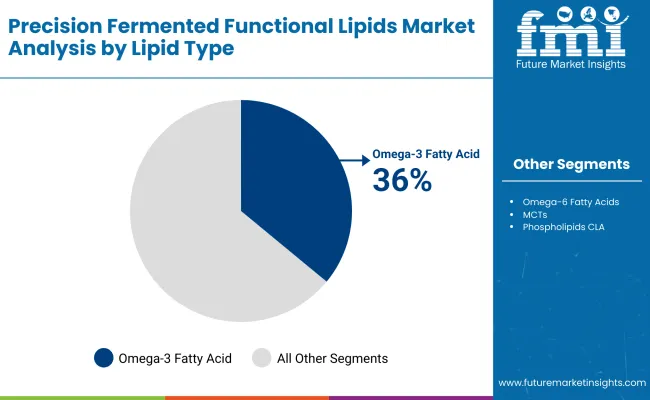
| Lipid Type Segment | Market Value Share, 2025 |
|---|---|
| Omega 3 Fatty Acids (EPA, DHA) | 35% |
| Sterols & Stanols | 20% |
Omega‑3 fatty acids are projected to dominate the lipid type segment, accounting for 35% of market revenue in 2025. Their leadership is being driven by extensive use in cardiovascular, cognitive, and infant health applications, especially where fish-based sources are unsuitable. Precision fermentation has enabled EPA and DHA production with enhanced purity, odor neutrality, and regulatory compliance, thereby accelerating B2B adoption across nutraceutical and medical-grade segments.
Omega‑3s are increasingly being incorporated into vegan formulations, which has positioned them at the forefront of plant-based innovation. As sustainability concerns mount around marine ecosystems, precision-fermented omega‑3s are expected to become the preferred source across regulated markets. Continuous R&D in strain enhancement and bioprocessing efficiency is likely to further strengthen this segment’s dominance by 2035.
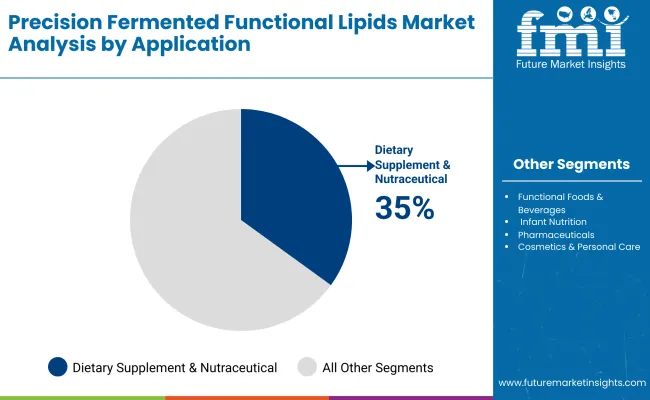
| Application Segment | Market Value Share, 2025 |
|---|---|
| Dietary Supplements & Nutraceuticals | 35% |
| Functional Foods & Beverages | 25% |
| Infant Nutrition | 15% |
Dietary supplements and nutraceuticals are anticipated to represent 35% of market revenues in 2025, making them the largest application category in the precision-fermented lipids space. Growth is being driven by consumer demand for sustainable, clean-label bioactives that support heart health, brain function, and metabolic balance. Fermented omega‑3s, phospholipids, and sterols have found wide use in this space due to their high bioavailability and absence of allergens or contaminants.
Supplement formulators have favored precision-fermented lipids for their standardized profiles, improved shelf stability, and vegan compatibility. Expansion through e-commerce, personalized nutrition platforms, and practitioner-grade distribution is expected to support further market penetration. As innovation in delivery formats and bioavailability enhancement continues, this segment is likely to remain the key driver of demand and innovation through 2035.
| Source Microorganism | Market Value Share, 2025 |
|---|---|
| Algae Derived Lipids | 40% |
| Yeast Derived Lipids | 28% |
| Fungi Derived Lipids | 20% |
Algae-derived lipids are expected to capture 40% of the market share in 2025, emerging as the leading source microorganism segment. This dominance is being shaped by their robust omega‑3 synthesis capabilities, higher cell density yields, and adaptability to closed-loop fermentation systems. Algae have been favored for their established safety profile, scalability, and ability to produce structured lipids like DHA with minimal post-processing.
This has made them the preferred platform in applications such as infant formula, medical nutrition, and plant-based emulsifiers. Precision fermentation has been applied to optimize lipid pathways in algae strains, enhancing productivity and lowering per-unit cost. As clean-label preferences grow and algae strains receive GRAS status across more geographies, this segment is expected to expand rapidly, driven by both technological refinement and regulatory momentum.
Rising production complexity and bioprocessing costs are posing challenges to large-scale commercialization, even as demand accelerates across nutrition, pharma, and cosmeceuticals. Precision fermentation is being positioned as a sustainable solution for next-gen lipid sourcing with scalable, clean-label potential.
Sustainable Sourcing Pressures Accelerating Lipid Fermentation Investments
Growing scrutiny of animal- and marine-derived lipid sources has intensified regulatory and consumer pressure on food and pharma companies to adopt sustainable alternatives. Precision fermentation has been embraced as a viable pathway due to its ability to decouple lipid production from biodiversity loss, climate risk, and contaminant exposure. In high-value lipid classes like omega-3 fatty acids and phospholipids, fossil fuel and fish oil dependency has been replaced by bio-identical outputs produced under controlled microbial environments.
Investment momentum has been fueled by ESG mandates and clean-label demand, particularly across Europe and North America. Multinational brands are expected to prioritize fermented lipids in reformulation pipelines to align with sustainability benchmarks and reduce supply volatility. As cost curves decline, demand-side pull is likely to outpace legacy lipid systems by 2030.
Microbial Strain Customization Enabling Targeted Lipid Profiles
Custom microbial strain engineering has been leveraged to produce highly specific lipid profiles tailored for targeted biofunctionality such as anti-inflammatory, neuroprotective, or skin-repair benefits. Companies are increasingly patenting designer strains capable of synthesizing niche fatty acids or ceramides with enhanced bioavailability.
This has expanded the application spectrum across medical nutrition, anti-aging skincare, and cognitive support formulations. Biofoundry automation and AI-led strain optimization are expected to further accelerate the development of precision-lipid libraries for B2B licensing, thereby transforming fermentation platforms into lipid-as-a-service models.
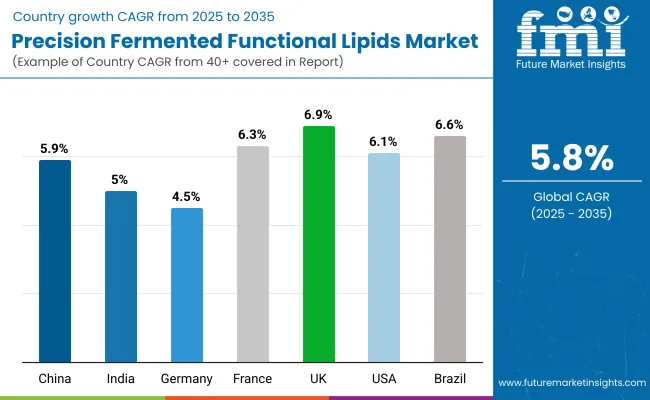
| Countries | CAGR |
|---|---|
| China | 5.9% |
| India | 5.0% |
| Germany | 4.5% |
| France | 6.3% |
| UK | 6.9% |
| USA | 6.1% |
| Brazil | 6.6% |
The global Precision-Fermented Functional Lipids Market is expected to experience varied growth trajectories across key countries, shaped by nutritional policy shifts, synthetic biology infrastructure, and clean-label consumer uptake. The UK leads with a 6.9% CAGR, supported by proactive regulatory support for microbial fermentation and its integration into sustainable food systems. Brazil follows closely at 6.6% CAGR, driven by its expanding nutraceutical exports and strong bio manufacturing ecosystem.
The United States is projected to grow at 6.1% CAGR, with demand anchored in pharmaceutical, clinical nutrition, and precision wellness sectors. France, with 6.3% CAGR, is benefiting from robust R&D investments and national protein strategy frameworks that support lipid bio-innovation. China’s growth at 5.9% CAGR is being powered by functional food demand and government-backed fermentation clusters, while India, growing at 5.0%, is witnessing adoption across urban wellness markets and export-oriented supplement formulations.
Germany exhibits a comparatively modest 4.5% CAGR, reflecting a stricter regulatory stance and slower uptake of novel lipids despite strong biotechnology capabilities. Overall, the highest momentum is being seen in countries with favorable GRAS pathways, dietary diversification, and investment in cell-based production platforms. Precision fermentation is thus positioned to scale unevenly, reflecting country-level readiness and demand maturity.
| Years | USA Precision Fermented Functional Lipids Market (USD Million) |
|---|---|
| 2025 | 152.5 |
| 2026 | 162.7 |
| 2027 | 170.9 |
| 2028 | 180.4 |
| 2029 | 191.4 |
| 2030 | 203.7 |
| 2031 | 217.7 |
| 2032 | 230.0 |
| 2033 | 242.6 |
| 2034 | 256.1 |
| 2035 | 269.2 |
The Precision-Fermented Functional Lipids Market in the United States is projected to grow at a CAGR of 6.1% during 2025-2035, driven by surging demand across clinical nutrition, biopharma formulation, and specialized dietary applications. The market is expected to expand from USD 152.5 million in 2025 to USD 269.2 million by 2035, reflecting consistent compound annual growth supported by innovation pipelines and clean-label reformulation strategies.
Adoption is being advanced by pharmaceutical companies seeking bioidentical, allergen-free lipids for injectable emulsions and capsule coatings. The dietary supplements sector has also embraced fermented lipids, particularly omega3 and phospholipids, owing to their purity, traceability, and vegan positioning. Regulatory support and GRAS pathways have enhanced market confidence among formulators.
Opportunities are being unlocked in infant nutrition, where long-chain polyunsaturated fatty acids (LC-PUFAs) produced through microbial fermentation are gaining traction as DHA alternatives. Moreover, demand from the personal care industry has been stimulated by precision-fermented ceramides and sterols used in anti-aging and skin-barrier restoration products.
The UK market for precision-fermented functional lipids is projected to expand at a CAGR of 6.9%, positioning it among the fastest-growing markets in Europe. Growth is expected to be fueled by government support for alternative proteins, clean-label initiatives, and pharma-grade lipid adoption.
Formulation of fortified foods and personalized supplements using microbially derived lipids is being scaled by domestic nutraceutical companies. Demand from cosmeceuticals is increasing, driven by consumer preference for vegan and allergen-free ceramides and sterols. The NHS has initiated pilots incorporating precision lipids in therapeutic dietary protocols.
India’s Precision Fermented Functional Lipids market is forecasted to grow at a robust CAGR of 6.79%, supported by increasing demand for traditional and functional wellness solutions. A strong inclination toward natural healing and ayurvedic integration has enabled early acceptance of bovine-derived ingredients in cognitive support and neurological recovery.
B2B nutraceutical manufacturers are actively adopting pharmaceutical- and food-grade extracts, with affordability and localized sourcing emerging as key value drivers. Improved regulatory support and evolving clinical validation frameworks are expected to reinforce trust among consumers.
The precision-fermented functional lipids market in China is forecasted to grow at a CAGR of 5.9%, led by strategic investment in food biotech zones and digital fermentation platforms. Government initiatives under “Healthy China 2030” are supporting precision nutrition and gut health innovation using microbially synthesized lipids.
Demand for infant and elderly nutrition is surging, where algae-derived DHA and structured lipids are being prioritized for their traceability and formulation stability. State-backed biotech hubs are enabling large-scale lipid production in closed-loop systems.
| Countries | 2025 |
|---|---|
| UK | 20.4% |
| Germany | 20.2% |
| Italy | 11.4% |
| France | 12.2% |
| Spain | 11.7% |
| BENELUX | 6.4% |
| Nordic | 5.7% |
| Rest of Europe | 12.1% |
| Countries | 2035 |
|---|---|
| UK | 19.3% |
| Germany | 21.4% |
| Italy | 9.8% |
| France | 13.4% |
| Spain | 10.0% |
| BENELUX | 5.2% |
| Nordic | 5.6% |
| Rest of Europe | 15.4% |
Germany is projected to register a CAGR of 4.5%, reflecting cautious but steady uptake of precision-fermented lipids in highly regulated sectors. Adoption is being seen in pharmaceutical lipid excipients and dermatological product lines, with strong oversight from food safety and drug regulatory bodies. The market is being shaped by pharma-led collaborations and ingredient standardization initiatives to meet EU-wide compliance. Although functional food applications remain limited, opportunities are expanding in prescription nutrition, skin barrier repair, and clinical trials for metabolic disorders.
| Product Type Segment | Market Value Share, 2025 |
|---|---|
| Omega 3 Fatty Acids (EPA, DHA) | 36.0% |
| Omega 6 Fatty Acids | 7.0% |
| Medium Chain Triglycerides (MCTs) | 10.0% |
| Phospholipids (Phosphatidylcholine, Phosphatidylserine) | 13.0% |
| Conjugated Linoleic Acid (CLA) | 8.0% |
| Specialized Fatty Acids (e.g., Stearidonic Acid) | 6.0% |
| Sterols & Stanols | 20.0% |
The Precision-Fermented Functional Lipids Market in Japan is expected to be valued at USD 26.7 million in 2025, led by omega3 fatty acids holding the largest segment share at 36%, followed by sterols and stanols (20%) and phospholipids (13%).
Market growth is being propelled by strong consumer awareness around cardiovascular and brain health, alongside a preference for plant-derived, bioidentical lipid sources. Japan’s legacy in precision nutrition and functional food development has catalyzed rapid adoption of fermented EPA and DHA, especially in elderly nutrition and clinical-grade supplements.
The segment’s expansion is also supported by innovation in structured lipid formulations for brain health and neuroprotection. Phospholipids, particularly phosphatidylcholine, are being integrated into smart foods and therapeutic beverages targeting cognitive function in aging populations. Regulatory flexibility under Japan’s FOSHU (Foods for Specified Health Use) framework has allowed quicker market entry for lipid-enhanced foods.
| Application Segment | Market Value Share, 2025 |
|---|---|
| Dietary Supplements & Nutraceuticals | 34.0% |
| Functional Foods & Beverages | 26.0% |
| Infant Nutrition | 16.0% |
| Pharmaceuticals | 14.0% |
| Cosmetics & Personal Care | 10.0% |
The Precision-Fermented Functional Lipids Market in South Korea is projected to witness rapid expansion across high-value wellness and clinical nutrition applications. In 2025, the dietary supplements & nutraceuticals segment is expected to lead with 34% share, followed by functional foods & beverages (26%) and infant nutrition (16%). This growth is being driven by a strong domestic demand for science-backed health products, supported by South Korea’s globally advanced nutraceutical and F&B innovation ecosystem.
Precision-fermented lipids are being positioned as premium bioactive ingredients, particularly in omega3, phospholipids, and MCT applications for cognitive, heart, and metabolic health. Infant nutrition brands are incorporating microbially derived lipids to meet rising demand for cleaner DHA and ARA inputs, especially in premium formulas. Functional beverage manufacturers are leveraging fermented lipids in ready-to-drink brain health and endurance beverages, targeting K-wellness consumers.
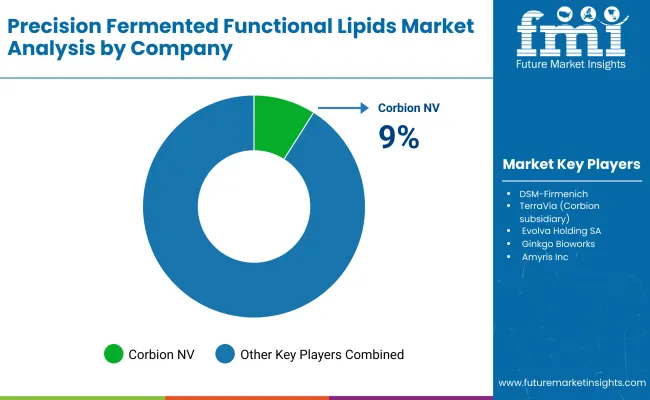
| Company | Global Value Share 2025 |
|---|---|
| Corbion NV | 9% |
| Others | 91% |
The Precision-Fermented Functional Lipids Market is moderately fragmented, with global leaders, mid-sized innovators, and niche-focused biotech firms competing across differentiated value chains. Global ingredient and fermentation leaders such as Corbion NV, DSM-Firmenich, Cargill, Inc., and BASF SE are holding dominant shares by leveraging advanced bioprocessing infrastructure, strain optimization, and vertically integrated platforms. Their strategies are increasingly oriented toward scaling lipid fermentation across multiple product classes, including EPA/DHA, ceramides, and structured lipids for functional food, infant nutrition, and personal care applications.
Established innovators such as Croda International Plc, Amyris, Inc., and Evolva Holding SA have been focusing on specialty segments through proprietary microbial chassis and fermentation-as-a-service models. These players are strengthening their competitive position via synthetic biology partnerships and novel product launches targeting brain, heart, and skin health.
Niche-focused players like Ginkgo Bioworks and TerraVia (Corbion) are offering customizable fermentation solutions tailored to ingredient licensing and biomanufacturing alliances. Their value lies in metabolic engineering, lipid design libraries, and application-specific fermentation routes.
The competitive focus is gradually shifting from product yield and purity toward IP portfolios, end-use customization, andplatform interoperability. Partnerships with F&B, pharma, and cosmeceutical companies are expected to intensify, redefining go-to-market pathways across regions.
Key Developments in Precision Fermented Functional Lipids
| Item | Value |
|---|---|
| Quantitative Units | USD 635.6 Million |
| Lipid Type | Precision-Fermented Lipid Types: Omega-3 Fatty Acids (EPA, DHA), Omega-6 Fatty Acids, MCTs, Phospholipids, CLA, Specialized Fatty Acids (e.g., Stearidonic Acid), Sterols & Stanols |
| Application | Dietary Supplements & Nutraceuticals, Functional Foods & Beverages, Infant Nutrition, Pharmaceuticals, Cosmetics & Personal Care |
| Source Microorganism | General Consumers, Infants & Children, Seniors, Medical & Clinical Nutrition Patients |
| Product Form | Oils & Oil Blends, Powders & Capsules, Emulsions & Lipid-Based Delivery Systems |
| End User | Pharmacies & Drugstores, Nutraceutical & Supplement Manufacturers (B2B), Research Institutions & Laboratories, Cosmetic Ingredient Suppliers, Online Retail |
| Sales Channel | Direct-to-Consumer (D2C), Health & Nutrition Stores, Pharmacies & Drugstores, Food & Beverage Manufacturers (B2B), Online Retail |
| Regions Covered | North America, Europe, Asia-Pacific, Latin America, Middle East & Africa |
| Country Covered | United States, Canada, Germany, France, United Kingdom, China, Japan, India, Brazil, South Africa |
| Key Companies Profiled | Corbion NV, DSM-Firmenich, TerraVia (Corbion subsidiary), Evolva Holding SA, Ginkgo Bioworks, Amyris Inc., Croda International Plc, Solazyme (Corbion), Cargill Inc., BASF SE |
| Additional Attributes | Global and regional revenue breakdown by lipid type, microbial source, and application; CAGR by country; emergence of lipid-as-a-platform models; strategic focus on vegan and allergen-free formulations; GRAS/FOSHU approval acceleration; synthetic biology and AI-led strain optimization. |
The global Precision Fermented Functional Lipids is estimated to be valued at USD 635.6 million in 2025.
The market size for the Precision Fermented Functional Lipids is projected to reach USD 1,116.2 million by 2035.
The Precision Fermented Functional Lipids is expected to grow at a 5.8% CAGR between 2025 and 2035.
The key lipid types in the Precision Fermented Functional Lipids Market are omega-3 fatty acids, MCTs, phospholipids, sterols & stanols, and specialized fatty acids, delivered via oils, powders, capsules, and emulsions.
In terms of application, The Dietary Supplements & Nutraceuticals segment is expected to command the largest share in 2025, contributing 35% of global revenues, followed by functional foods and infant nutrition.






Our Research Products

The "Full Research Suite" delivers actionable market intel, deep dives on markets or technologies, so clients act faster, cut risk, and unlock growth.

The Leaderboard benchmarks and ranks top vendors, classifying them as Established Leaders, Leading Challengers, or Disruptors & Challengers.

Locates where complements amplify value and substitutes erode it, forecasting net impact by horizon

We deliver granular, decision-grade intel: market sizing, 5-year forecasts, pricing, adoption, usage, revenue, and operational KPIs—plus competitor tracking, regulation, and value chains—across 60 countries broadly.

Spot the shifts before they hit your P&L. We track inflection points, adoption curves, pricing moves, and ecosystem plays to show where demand is heading, why it is changing, and what to do next across high-growth markets and disruptive tech

Real-time reads of user behavior. We track shifting priorities, perceptions of today’s and next-gen services, and provider experience, then pace how fast tech moves from trial to adoption, blending buyer, consumer, and channel inputs with social signals (#WhySwitch, #UX).

Partner with our analyst team to build a custom report designed around your business priorities. From analysing market trends to assessing competitors or crafting bespoke datasets, we tailor insights to your needs.
Supplier Intelligence
Discovery & Profiling
Capacity & Footprint
Performance & Risk
Compliance & Governance
Commercial Readiness
Who Supplies Whom
Scorecards & Shortlists
Playbooks & Docs
Category Intelligence
Definition & Scope
Demand & Use Cases
Cost Drivers
Market Structure
Supply Chain Map
Trade & Policy
Operating Norms
Deliverables
Buyer Intelligence
Account Basics
Spend & Scope
Procurement Model
Vendor Requirements
Terms & Policies
Entry Strategy
Pain Points & Triggers
Outputs
Pricing Analysis
Benchmarks
Trends
Should-Cost
Indexation
Landed Cost
Commercial Terms
Deliverables
Brand Analysis
Positioning & Value Prop
Share & Presence
Customer Evidence
Go-to-Market
Digital & Reputation
Compliance & Trust
KPIs & Gaps
Outputs
Full Research Suite comprises of:
Market outlook & trends analysis
Interviews & case studies
Strategic recommendations
Vendor profiles & capabilities analysis
5-year forecasts
8 regions and 60+ country-level data splits
Market segment data splits
12 months of continuous data updates
DELIVERED AS:
PDF EXCEL ONLINE
Precision Livestock Farming Market Size and Share Forecast Outlook 2025 to 2035
Precision Wire Drawing Service Market Size and Share Forecast Outlook 2025 to 2035
Precision Planting Market Size and Share Forecast Outlook 2025 to 2035
Precision Bearing Market Size and Share Forecast Outlook 2025 to 2035
Precision Laser Engraving Machines Market Size and Share Forecast Outlook 2025 to 2035
Precision Analog Potentiometer Market Size and Share Forecast Outlook 2025 to 2035
Precision Blanking Dies Market Size and Share Forecast Outlook 2025 to 2035
Precision Components And Tooling Systems Market Size and Share Forecast Outlook 2025 to 2035
Precision Chemicals Market Size and Share Forecast Outlook 2025 to 2035
Precision Fermentation Ingredients Market Size and Share Forecast Outlook 2025 to 2035
Precision Ruminant Minerals Market Analysis - Size and Share Forecast Outlook 2025 to 2035
Precision Forestry Market Size and Share Forecast Outlook 2025 to 2035
Precision Stainless Steel Market Size and Share Forecast Outlook 2025 to 2035
Precision Machine For Polymers Market Size and Share Forecast Outlook 2025 to 2035
Precision Aquaculture Market Size and Share Forecast Outlook 2025 to 2035
Precision Gearbox Machinery Market Trends and Forecast 2025 to 2035
Precision Cancer Imaging Market Growth - Industry Trends & Forecast 2025 to 2035
Precision Poultry Nutrition Market – Growth, Demand & Livestock Trends
Precision Agriculture Market
Precision-Fermented Casein for QSR Pizza Cheese Market Analysis - Size, Share, and Forecast Outlook 2025 to 2035

Thank you!
You will receive an email from our Business Development Manager. Please be sure to check your SPAM/JUNK folder too.
Chat With
MaRIA